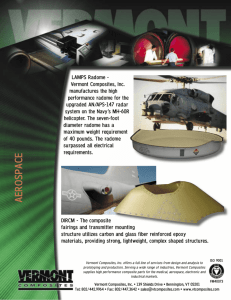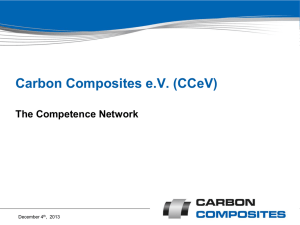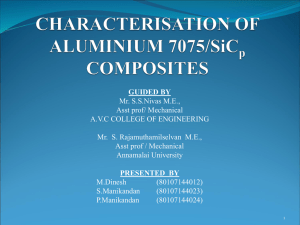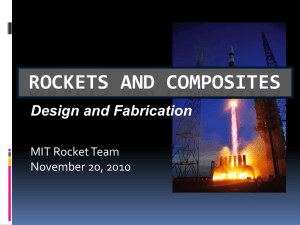Studies on the chemical resistance and mechanical properties of
advertisement
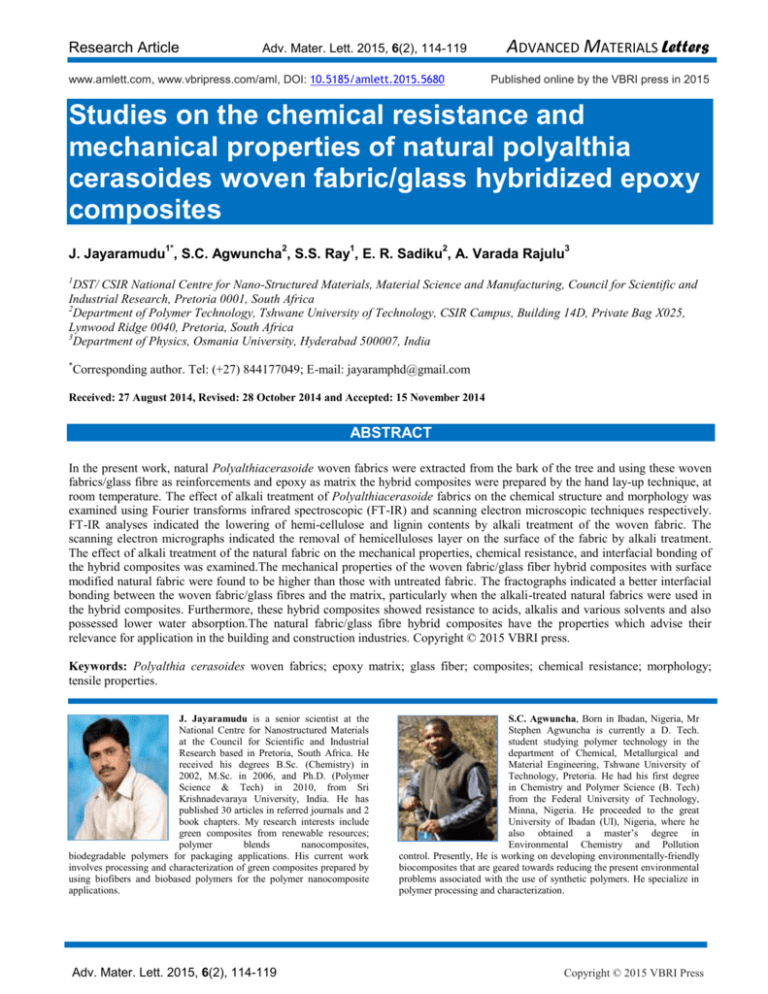
Research Article Adv. Mater. Lett. 2015, 6(2), 114-119 www.amlett.com, www.vbripress.com/aml, DOI: 10.5185/amlett.2015.5680 ADVANCED MATERIALS Letters Published online by the VBRI press in 2015 Studies on the chemical resistance and mechanical properties of natural polyalthia cerasoides woven fabric/glass hybridized epoxy composites J. Jayaramudu1*, S.C. Agwuncha2, S.S. Ray1, E. R. Sadiku2, A. Varada Rajulu3 1 DST/ CSIR National Centre for Nano-Structured Materials, Material Science and Manufacturing, Council for Scientific and Industrial Research, Pretoria 0001, South Africa 2 Department of Polymer Technology, Tshwane University of Technology, CSIR Campus, Building 14D, Private Bag X025, Lynwood Ridge 0040, Pretoria, South Africa 3 Department of Physics, Osmania University, Hyderabad 500007, India * Corresponding author. Tel: (+27) 844177049; E-mail: jayaramphd@gmail.com Received: 27 August 2014, Revised: 28 October 2014 and Accepted: 15 November 2014 ABSTRACT In the present work, natural Polyalthiacerasoide woven fabrics were extracted from the bark of the tree and using these woven fabrics/glass fibre as reinforcements and epoxy as matrix the hybrid composites were prepared by the hand lay-up technique, at room temperature. The effect of alkali treatment of Polyalthiacerasoide fabrics on the chemical structure and morphology was examined using Fourier transforms infrared spectroscopic (FT-IR) and scanning electron microscopic techniques respectively. FT-IR analyses indicated the lowering of hemi-cellulose and lignin contents by alkali treatment of the woven fabric. The scanning electron micrographs indicated the removal of hemicelluloses layer on the surface of the fabric by alkali treatment. The effect of alkali treatment of the natural fabric on the mechanical properties, chemical resistance, and interfacial bonding of the hybrid composites was examined.The mechanical properties of the woven fabric/glass fiber hybrid composites with surface modified natural fabric were found to be higher than those with untreated fabric. The fractographs indicated a better interfacial bonding between the woven fabric/glass fibres and the matrix, particularly when the alkali-treated natural fabrics were used in the hybrid composites. Furthermore, these hybrid composites showed resistance to acids, alkalis and various solvents and also possessed lower water absorption.The natural fabric/glass fibre hybrid composites have the properties which advise their relevance for application in the building and construction industries. Copyright © 2015 VBRI press. Keywords: Polyalthia cerasoides woven fabrics; epoxy matrix; glass fiber; composites; chemical resistance; morphology; tensile properties. J. Jayaramudu is a senior scientist at the National Centre for Nanostructured Materials at the Council for Scientific and Industrial Research based in Pretoria, South Africa. He received his degrees B.Sc. (Chemistry) in 2002, M.Sc. in 2006, and Ph.D. (Polymer Science & Tech) in 2010, from Sri Krishnadevaraya University, India. He has published 30 articles in referred journals and 2 book chapters. My research interests include green composites from renewable resources; polymer blends nanocomposites, biodegradable polymers for packaging applications. His current work involves processing and characterization of green composites prepared by using biofibers and biobased polymers for the polymer nanocomposite applications. Adv. Mater. Lett. 2015, 6(2), 114-119 S.C. Agwuncha, Born in Ibadan, Nigeria, Mr Stephen Agwuncha is currently a D. Tech. student studying polymer technology in the department of Chemical, Metallurgical and Material Engineering, Tshwane University of Technology, Pretoria. He had his first degree in Chemistry and Polymer Science (B. Tech) from the Federal University of Technology, Minna, Nigeria. He proceeded to the great University of Ibadan (UI), Nigeria, where he also obtained a master’s degree in Environmental Chemistry and Pollution control. Presently, He is working on developing environmentally-friendly biocomposites that are geared towards reducing the present environmental problems associated with the use of synthetic polymers. He specialize in polymer processing and characterization. Copyright © 2015 VBRI Press Research Article Adv. Mater. Lett. 2015, 6(2), 114-119 S. S. Ray received his PhD in Physical Chemistry at the University of Calcutta, India in 2001. He has a long list of accolades to his name. In 2011, he was rated as one of the top 50 high impact chemists in the world, while in 2013 he received the most prestigious awards for polymer processing from the International Polymer Processing Society)- the Morand Lambla Award. Ray is one of the most active and highly cited authors in the field of polymer nanocomposite materials globally; and his work has featured on various international journal covers. He was recently listed in the Top 1% of most impactful and influential scientists by Thomson Reuters Essential Science Indicators. Ray is the author of two books, has co-authored three, 11 book chapters on various aspects of polymer based nano-structured materials and their applications; and also author/co-authored 209 articles in high-impact international journals. He also has four patents shared with collaborators. Introduction In the present circumstances, one of the leading scientific and technological challenges of the day is to create new materials for innovative applications. In this direction, new fiber-reinforced materials called hybrid composites [1], were created and are continually being developed. As the mechanical properties of the hybrid composites are comparable to glass fiber-reinforced composites, they should provide exceptional properties and the preparation methods should be available, at a reasonably lower cost. Currently, the usage of hybrid composites is increasing dayby-day because of their high strength-to-weight ratio and ease of fabrication. Several studies on composites made from epoxy matrix and natural fibers such as: jute, wood, banana, sisal, cotton, coir and wheat straw were reported in the literature. Most of the studies in this area were mainly focused on the improvement of the inherent weakness of natural fiber composites. This was accomplished by inducing the hydrophobicity in the natural fibers through various physical and chemical pretreatments of the fibers [2-7]. Yang et al. [7] studied the mechanical and interfacial properties of sisal/glass fiber-reinforced PVC hybrid composites. Mishra et al. [9] studied the mechanical performance of biofibre/glass reinforced hybrid composites. They observed that the addition of relatively small amount of glass fibre to pineapple leaf fibre and sisal fibre reinforced polyester matrix enhanced the mechanical properties of the resulting hybrid composites. Kalaprasad et al. [10, 11] prepared the low-density polyethylene-based short sisal/glass fiber hybrid composites and found a considerable enhancement in the mechanical properties of the hybrid composites. Harani et al. [12] and Park et al. [13] toughened epoxy resin using hydroxyl terminated polyester. They reported an improvement in the physical properties of these composites as a result of toughening. Varada Rajulu et al. [14] studied the tensile properties of glass mat reinforced epoxy toughened with polycarbonate and they reported an improvement in the tensile strength on toughening. Recently, Jayaramudu et al. [15] studied the properties of natural fabric polyalthiacerasoides. They carried the characterization of untreated and alkali treated new natural cellulosic fabric polyalthiacerasoideswoven fabric by investigating its mechanical, morphological, chemical analysis, structural, and thermal properties. Adv. Mater. Lett. 2015, 6(2), 114-119 ADVANCED MATERIALS Letters Jayaramudu et al. [16] also studied the thermal degradation of polyalthiacerasoideswoven fabric. In their study, they reported that the initial degradation temperature of polyalthiacerasoides woven fabric to be 243 °C. The objective of this study was to develop natural woven fabric hybrid composite from a moderately new, but widely available Polyalthiacerasoides woven fabrics (PCWFs). In this work, the effect of alkali treatment of the natural fabric on the mechanical properties, chemical resistance, water absorption, interfacial bonding of the hybrid composites was studied. Experimental Materials In the present work, Polyalthiacerasoides woven natural fabrics, glass fibers, the epoxy resin Araldite LY-556 and Hardener HY-951 (ECMOS Corporation, Ltd; Hyderabad, India) were used as the composite components. Besides these, sodium hydroxide pellets (Merk specialities private limited, Mumbai, India) were used for the treatment of the natural fabric. Extraction of the PCWFS from the tree Fabric samples of PCWFs were extracted from the bark of the tree, Polyalthiacerasoides. In order to protect the tree, the fabric was separated from its branches only, as described elsewhere [15]. The extracted PCWFs were washed thoroughly in distilled water and allowed to dry in the sun for seven days. The PCWFs were further dried in vacuum oven for one day, prior to using it as reinforcement. Some quantity of the PCWFs was treated with 5% aq. NaOH solution for four hours, neutralized with dilute acetic acid, washed thoroughly with distilled water and then dried at 80 ºC for 24 h and subsequently stored. The samples were also re-dried before analysis. Mould preparation A mould with dimensions 200 mm x 200 mm x 3 mm cavity was used in this work. The mold cavity was cleaned in order to remove particles and then coated with layers of releasing agent (polyvinyl alcohol (PVA), which acts as a good releasing agent) for easy removal of the hybrid composite. Preparation of the hybrid composite and the test specimens A 3 mm thick laminate was made from the epoxy and hardener, taken in the ratio of 100:10 parts by weight, respectively. The moulding box was loaded with the matrix mixture and PCWFs/glass fiber (GF) (with varying percentage) which was placed in vacuum oven maintained at 70 ºC for 3 hours in order to complete the curing. In all cases of composite preparation (Fig. 1), the total content of the reinforcement was maintained at 40% (w/w). After curing, the plate was removed from the moulding box with simple tapering and was cut into tensile test specimens with 150 mm x 15 mm x 3 mm dimensions and for chemical test with dimensions of 10 mm x 5 mm x 3 mm. For comparison, the specimens for matrix material were also prepared in similar manner. Copyright © 2015 VBRI Press Jayaramudu et al. them on both sides with the filter paper at room temperature. The treated samples were then re-weighed and the %weight loss/gain was determined. In each case, ten samples were tested and their average values are reported. Results and discussion Fig. 1. Fabrication procedure of the hybrid composite. FT-IR spectral analysis Some of the samples were cryogenically cooled and powdered. This powder was diluted to 1%, using KBr and pellets were prepared employing a hydraulic press. FT-IR spectra of the untreated and the alkali-treated samples were recorded in the 4000–500 cm-1 region on a Perkin Elmer 16PC FT-IR instrument with 32 scans in each case at a resolution of 4 cm-1. The plant from which the Polyalthiacerasoides woven fabrics extracted belong to the Annonaceae family. FTIR spectra of untreated and alkali treated fabrics of Polyalthiacerasoideswoven fabrics are depicted in Fig. 2. The compositional changes between untreated and alkalitreated PCWFs are shown in Fig. 2. The spectra show the presence of hydroxyl, carbonyl, ether groups and absorbed water in the untreated PCWFs. The important changes in the FTIR spectra are associated with the peak intensities at around 3340, 2928,1740, 1630, 1420, 1370, 1030 cm -1. As shown in Fig. 2, intensity of the hemicellulose peak around 1740 cm-1 [17] decreased when the fabric was treated with alkali. This indicates the fact that the hemicellulose was almost removed completely by the alkali treatment. This is quite expected as the hemicellulose is soluble in aqueous NaOH (alkali) solution [6, 18, 19]. Microscopic analysis The morphology of the fractured samples was examined using the JEOL JSM 820 scanning electron microscope (SEM) operating with secondary electron imaging at 15 kV. The composite samples were cryogenically cooled and brittle fractured. The fractured surfaces were coated with gold by electro-deposition in order to impart electrical conduction before recording the micrographs. Tensile properties The tensile stress and tensile moduli were determined using Instron 3369 Model UTM. The crosshead speed for tensile test was maintained at 5 mm/minute. In each case, 10 samples were tested and the average is reported. Chemical resistance of hybrid composite The chemical resistance of the composites was studied as per ASTMD 543-87 method. This method covers the testing of the resistance of all plastic materials including cast, hot-molded, cold molded and laminates and describes the procedure for reporting changes in weight, dimensions, appearance and strength properties by the action of chemical reagents. Standard reagents are specified and exposed to reagents at elevated temperature in order to establish the results on a comparable basis. In the present work, chemical resistance tests were conducted on PCWFs/ glass fiber hybrid epoxy composites. Hoverer, we judiciously selected three acids, three bases and three solvents for this study. Glacial Acetic acid (8%), con. nitric acid (40%), con. hydrochloric acid (10%), con ammoniunhydroxide (10%), aq. sodium carbonate (20%), aq. sodium hydroxide (10%), toluene (250ml), benzene (250ml), and carbontetrachloride (250ml) were used after purification. The water absorption by the composites was also studied. In each case, the samples were pre-weighed in a precision electronic balance and dipped in the respective chemicals for 24 hours. They were removed and immediately washed in distilled water and dried by pressing Adv. Mater. Lett. 2015, 6(2), 114-119 Fig. 2. FTIR spectra of untreated and alkali treated polyalthiacerasoides woven fabric. The strong broad band observed around 3340 cm-1 in the spectra was due to the hydrogen bonded O-H stretching vibrations of polyalthiacerasoides fabrics. Hydroxyl groups were also involved in hydrogen bonding with the carboxyl groups, cellulose, pectin, lignin, hemicelluloses that were available on the fabric surface of natural fabric. The medium intensity band at 2928 cm-1 was attributed to the CH stretching frequency in methyl and methylene groups. The absorption band at 1630 cm-1 was due to the vibrations of adsorbed water molecule in the non-crystalline region of cellulose which appeared as a shoulder in the spectra. The peak at 1420 cm-1 was caused by CH2symmetric bending. The band at 1370 cm-1 was assigned to C-H deformation (symmetric) arising from polysaccharides. The peak at 1030 cm-1 was assigned to Symmetric C-OH stretching of lignin [20, 21]. Copyright © 2015 VBRI Press 116 Research Article Adv. Mater. Lett. 2015, 6(2), 114-119 Scanning electron micrographs of the untreated and alkali-treated (%5 NaOH) Polyalthiacerasoides woven fabrics and their hybrid composites are represented in Fig. 3 (a), (b), (c) and (d), respectively. From Fig. 3 (a), it can be seen that the gummy polysaccharides of lignin, hemicellulose and pectin were localized as white deposits on the surfaces of untreated woven fabrics. The woven fabrics were slightly interwoven and loosely bound with other natural fabrics [22-24]. It is clearly indicated that the white layer was not evenly distributed along the woven fabrics surface, but its thickness varied from point-to-point. As seen in Fig. 3(b), the alkali-treated woven fabrics had highly reduced thickness and appeared to have clean, but rough surface with large number of etched striations. These micrographs also reveal the uniaxial orientation of fabrics in parallel direction and they also had many void regions. The rough and clean surface morphologies of the alkalitreated fabrics are expected to assist in the direct interaction of the woven fabrics with the polymer matrix. They could be separated into a single bundle of fabrics with few micro void regions. ADVANCED MATERIALS Letters treated PCWF/GF hybrid epoxy composite, the interfacial adhesion between the woven fabric and matrix was comparatively stronger, as indicated in Fig. 3 (d). These observations indicate that the bonding between the reinforcements and the matrix was improved significantly when compared to the untreated hybrid composites. This was due to the fact that, the PCWF treated with alkali led to increased roughness of woven fabric surface, while the hemi-cellulose and some parts of the lignin were removed as confirmed by Fig. 3(b). Further, the woven fabric became thin and thus creating a good interlocking mechanism with the surface of epoxy matrix. The cleared micro-pores thus, facilitate good mechanical bonding between the woven fabrics and the matrix. Fig. 3 (d) shows that the NaOH-treated PCWF/GF in the hybrid epoxy composite was broken and not pulled-out, because of the good interfacial bonding. This clearly indicates that there is a strong bonding between the reinforcements (fabrics/glass fiber) and epoxy matrix. Furthermore, matrix skin formation was observed on the surface of the woven fabrics. These observations indicate that the bonding between the reinforcements and the matrix was good. Similarly, the bonding was strong when alkali treatment was employed. This observation gives direct evidence about the adhesion improvement at the interface (in the presence of reactive alkali), in the treatment of hybrid composites. These arguments were also reflected in all the mechanical properties investigated. Fig. 3. The scanning electron micrographs (SEM) of polyalthiacerasoides woven fabrics (a) Untreated woven fabric, (b) alkali treated, (c) Untreated woven fabric/glass hybrid composites and (d) alkali treated/glass hybrid composites. Observation with the naked eye, Polyalthiacerasoides woven fabrics were uniaxially oriented in the composites. Fig. 3 (c) and (d) display the SEM micrographs of the fractured surfaces of PCWFs (untreated and alkalitreated)/GFhybrid epoxy-based composites and interface studies were carried out in order to investigate Polyalthiacerasoides woven fabrics/glass fiber hybrid epoxy interaction by SEM studies. In the case of untreated PCWF/GF hybrid composites, shown in Fig. 3(c), a poor interfacial bonding was indicated with clear pull out, detachment and deboning between PCWF/GF and epoxy matrix and these effects produced a relatively clean surface over the pulled out-woven fabrics and glass fiber, due to the great extent of delamination. Fig. 3(c) also explains the fact that the fabric and GF were not clearly bonded with the matrix in the untreated PCWF/GF hybrid epoxy composite, resulting in low mechanical properties of the hybrid composites (Fig. 3 and 4). However, in the case of NaOH- Adv. Mater. Lett. 2015, 6(2), 114-119 Fig. 4. Variation of maximum tensile stress at different ratios of % glass fiber/Polyalthia cerasoides woven fabrics reinforced epoxy composites. The variation of tensile stress and tensile modulus with % GF/PCWF ratio is presented in Fig. 4 and Fig. 5 respectively. For comparison, values for the matrix are also presented in the same figures. From these figures, it is evident that the tensile properties were enhanced when alkali-treated PCWFs were used in the hybrid composites. This is understandable as the contents of weak amorphous hemicellulose and lignin were decreased following alkali treatment (refer to Fig. 2).The clear micro-pores might have thus facilitated good mechanical bonding between the fabrics and the matrix. The minimum and maximum tensile moduli for these composites were found to be 2809 and 10972 MPa, respectively. Similarly, the stress values varied in the range between 58 and 238 MPa. The 20/20 showed the best mechanical properties, amongst all the composites studied. Similar observation was made by Copyright © 2015 VBRI Press Jayaramudu et al. Vararda Rajulu et al. [25, 26] and Srinivasulu et al. [27] in the case of bamboo composites and polymer-coated bamboo fibers. Thus, the hybrid composites under study have good tensile properties. The resistance of the composites to water and certain chemicals was studied. Three acids (HCl, HNO3 and CH3COOH), two alkalis (NaOH and NH4OH), a salt (Na2CO3) and three commonly used solvents (C6H6, C7H8, and CCl4) were used. The water absorption characteristics of these composites were also studied. From Table 1, it is clearly evident that for the matrix and composite, weight gain was observed after immersion in acids. In all cases, a weight increase was observed. Fig. 5. Variation of tensile modulus at different ratios of % glass fiber/Polyalthiacerasoides woven fabrics reinforced epoxy composites. Table 1. Resistance of polyalthia cerasoides woven fabric/glass fiber reinforced epoxy hybrid composite to chemical reagents. Chemicals Matrix (Epoxy) Epoxy-based hybrid composites 40% Nitric acid (HNO3) +0.3214 (40%) 10% Hydrochloric acid +0.7695 (HCl) 8% Acetic acid (CH3COOH) +0.1435 +0.5027 10% Sodium hydroxide (NaOH) 10% Ammonium Hydroxide (NH4OH) 20% Sodium carbonate (Na2CO3) Benzene (C6H6) Toluene ( C7 H8) Carbon tetrachloride (CCl4) +0.3201 +0.3026 -1.9758 -1.3542 0.2956 -0.3692 0.6957 0.3641 0.3042 -0.8632 -0.2809 -2.0438 Water (H2O) 0.1042 -1.0589 +0.2379 +0.2401 case of short bamboo fiber reinforced high performance epoxy composites. It was also observed that the effect of other chemicals was negligible on the matrix and the hybrid composites. Furthermore, water absorption by the matrix and the hybrid composites under study was also observed to be negligible. Thus, based on the tensile properties and the chemical resistance, the hybrid composites under study can suitably be considered for applications in making acid/water storage tanks, tabletops, automotive sector, the building and construction industries and airspace applications. Conclusion Hybrid composites of glass fiber/Polyalthia cerasoides woven natural fabric reinforced epoxy were made and their tensile properties, FT-IR analyses, morphology and chemical resistance were studied. FT-IR analyses indicated a decrease in the hemicellulose and lignin contents following alkali treatment.These hybrid composites were found to exhibit good tensile and chemical resistance properties. The hybrid composites with alkali treated (PCWFs) were found to possess higher tensile properties. These composites were found to be resistant to certain acids, alkalis and solvents. The SEM micrographs of the specimens revealed that alkali-treated PCWFs/GF epoxy hybrid composites had better fabric-matrix adhesion over the untreated PCWFs/GF epoxy hybrid composites. The elimination of the amorphous hemi-cellulose components from the PCWFs following alkali treatment was believed to be responsible for this behavior. The hybrid composites with composition 20/20 showed the best mechanical properties, amongst all studied. The hybrid composite had properties which suggest their suitability for applications in the building and construction industries as panels for partitioning and flooring, storage tanks and table tops. This is because of its good chemical resistance. It is also suitable for wall coverings, architectural landscaping in order to replace the hardwood that is currently used, hence preserving the environment. Acknowledgements The researchers would like to thank the Tshwane University of Technology, Pretoria, South Africa for providing the post-doc fellowship and research Grant and the National Centre for Nano-Structured Materials, CSIR, Pretoria, for their supports. The author AVR thanks the Council of Scientific and Industrial Research of India for the award of an Emeritus Scientist, Scheme [21(0842)11/EMR-II dt: 10-05- 2011]. Reference 1. This clearly indicates that the composites did not lose weight and therefore no erosion of materials occurred. Generally, the weight increase was larger for water or aqueous solutions and this was to be expected because of the hydrophilicity of the fabric. This conclusion was supported by the weight increase in the presence of these liquids with increasing fabric content. In these cases, the OH groups in the cellulose were better exposed and increased the hydrophilicity of the system [28]. Similar observation was made by Varada Rajulu et al. [29] in the Adv. Mater. Lett. 2015, 6(2), 114-119 2. 3. 4. 5. 6. Naveen, V. P.; Vani, A.; Prakasha, V.; Divakar, C. J.; Ananthkrishnan, T.; Rao, R. M. V. G. K.; J. Rein. Plastics Compos. 2000, 19, 396. DOI: 10.1177/073168440001900504 George, J.; Bhagawan, S. S.; Thomas, S. Compos. Sci. Technol. 1998, 58, 1471. DOI: 10.1016/S0266-3538(97)00161-9 Stamboulis, A.; Baillie, C. A.; Garkhail, S. K.; van Melick, H. G. H.; Peijs, T.; Appl. Compos. Mater. 2000, 7, 273. DOI: 10.1023/a:1026581922221 Lin, Q.; Zhou, X.; Dai, G.; J. Appl. Polym. Sci. 2002, 85, 2824. DOI: 10.1002/app.10844 Tajvidi, M.; Ebrahimi, G.; J. Appl. Polym. Sci. 2003, 88, 941. DOI: 10.1002/app.12029 Arbelaiz, A.; Fernández, B.; Ramos, J. A.; Retegi, A.; Llano-Ponte, R.; Mondragon, I.; Compos. Sci. Technol. 2005, 65, 1582. Copyright © 2015 VBRI Press 118 Research Article 7. 8. 9. 10. 11. 12. 13. 14. 15. 16. 17. 18. 19. 20. 21. 22. 23. 24. 25. 26. 27. 28. 29. Adv. Mater. Lett. 2015, 6(2), 114-119 ADVANCED MATERIALS Letters DOI: http://dx.doi.org/10.1016/j.compscitech.2005.01.008 Kalia, S.; Kumar, A.; Kaith, B. S.; Adv. Mat. Lett. 2011, 2, 17. DOI: 10.5185/amlett.2010.6130 Yang, G.C.; Zeng, H. M.; Jian, N.B.; Li, J.J.; Plastics Ind. 1996, 1, 79. Mishra, S.; Mohanty, A. K.; Drzal, L. T.; Misra, M.; Parija, S.; Nayak, S. K.; Tripathy, S. S.; Compos. Sci. Technol. 2003, 63, 1377. DOI: http://dx.doi.org/10.1016/S0266-3538(03)00084-8 Kalaprasad, G.; Joseph, K.; Thomas, S.; J. Compos. Mater. 1997, 31, 509. DOI: 10.1177/002199839703100504. Kalaprasad, G.; Thomas, S.; Pavithran, C.; Neelakantan, N. R.; Balakrishnan, S.; J. Reinforced Plastics Compos. 1996, 15, 48. DOI: 10.1177/073168449601500104. Harani, H.; Fellahi, S.; Bakar, M.; J. Appl. Polym. Sci. 1999, 71, 29. DOI:10.1002/(sici)1097-4628(19990103)71:1<29::aidapp5>3.0.co;2-7 Park, S.-J.; Park, W.-B.; Lee, J.-R.; Polym J 1999, 31, 28. DOI: 10.1295/polymj.31.28 Rajulu, A. V.; Rao, G. B.; Reddy, R. L.; Balaji, P. J.; He, J.; Zhang, J.; J. Reinforced Plastics Compos. 2002, 21, 577. DOI: 10.1177/0731684402021006834 Jayaramudu, J.; Jeevan Prasad Reddy, D.; Guduri, B. R.; Varada Rajulu, A.; Fibers Polym. 2009, 10, 338. DOI: 10.1007/s12221-009-0338-8. Jayaramudu, J.; Reddy, K. O.; Maheswari, C. U.; Reddy, D. J. P.; Rajulu, A. V.; J. Reinforced Plastic Compos. 2009, 28, 2177. DOI: 10.1177/0731684408092066. Reddy, K. O.; Guduri, B. R.; Rajulu, A. V.; J. Appl. Polym. Sci. 2009, 114, 603. DOI: 10.1002/app.30584. Maepa, C. E.; Jayaramudu, J.; Okonkwo, J. O.; Ray, S. S.; Sadiku, E. R.; Ramontja, J.; Int. J. Polym. Anal. Charact. 2014. DOI: 10.1080/1023666X.2014.961118. Kalia, S.; Sheoran, R.; Mittal, H.; Kumar, A.; Adv. Mat. Lett. 2013, 4, 742. DOI: 10.5185/amlett.2013.3441. Jayaramudu, J.; Reddy, G. S. M.; Varaprasad, K.; Sadiku, E. R.; Ray, S. S.; Rajulu, A. V.; Adv. Polym. Technol. 2013, 32. DOI: 10.1002/adv.21349. Jayaramudu, J.; Reddy, D. J. P.; Guduri, B. R.; Rajulu, A. V.; Iran. Polym. J. 2009, 18, 693. Jayaramudu, J.; Maity, A.; Sadiku, E.; Guduri, B.; Varada Rajulu, A.; Ramana, C.; Li, R.; Carbohydr. Polym. 2011, 86, 1623. DOI: 10.1016/j.carbpol.2011.06.071 Jayaramudu, J.; Guduri, B.; Varada Rajulu, A.; Carbohydr. Polym. 2010, 79, 847. DOI: 10.1016/j.carbpol.2009.10.046 Jayaramudu, J.; Guduri, B.; Rajulu, A. V.; Int. J. Polym. Anal. Charact. 2009, 14, 115. DOI: 10.1080/10236660802601415 Varada Rajulu, A.; Narasimha Chary, K.; Rama Chandra Reddy, G. J.; Bamb Ratt 2003, 2, 95. Rajulu, A. V.; Devi, L. G.; Rao, G. B.; Reddy, R. L.; J. Reinforced Plastics Compos. 2003, 22, 1029. DOI: 10.1177/0731684403024571 Srinivasulu, S.; Varada Rajulu, A.; Ramachandra Reddy, G.; Bull. Pur. Appl Sci 2006, 25, 137. Singha, A. S.; Thakur, V. K.; Polym. Plastics Technol. Eng. 2009, 48, 736. DOI: 10.1080/03602550902824622 Rajulu, A. V.; Reddy, G. R.; Chary, K. N.; Ind. J. Fibre Text. Res 1996, 21, 223. Adv. Mater. Lett. 2015, 6(2), 114-119 Copyright © 2015 VBRI Press



